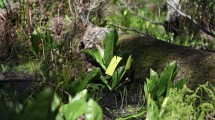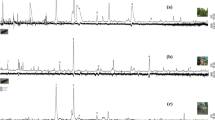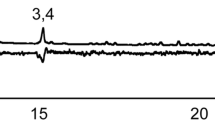Abstract
Fractionation of headspace volatiles fromCucurbita maxima blossoms by high-performance liquid chromatography resulted in the isolation of a single component which was highly active in an electroantennogram bioassay onDiabrotica undecimpunctata howardi antennae. This compound was identified as indole by gas chromatography-mass spectrometry. Field-trapping bioassays were conducted which indicated that indole is a potent attractant of the western corn rootworm,D. virgifera virgifera, and the striped cucumber beetle,Acalymma vittatum. The southern corn rootworm,D. u. howardi, did not respond, despite its strong EAG response. The sex ratio ofD. v. virgifera found in indole-baited traps varied seasonally. Males were trapped in abundance in late July and later September, 1983, while females were more abundant August and early September. The effectiveness of indole as aD. v. virgifera attractant also varied seasonally. A prolonged period of depressed trap catches occurred in early August 1983, during the silking and tasseling period of the corn in the field where trapping was carried out.
Similar content being viewed by others
References
Andersen, J.F. 1984. The role of attractants and feeding stimulants in the selection ofCucurbita flowers by diabroticite beetles (Coleoptera: Chrysomelidae). Unpublished PhD thesis. University of Illinois.
Bach, C.E. 1977. Distribution ofAcalymma vittata andDiabrotica virgifera (Coleoptera: Chrysomelidae) on cucurbits.Great Lakes Entomol. 10:123–125.
Branson, T.F., andGuss, P.L. 1983. Olfactory response ofDiabrotica spp. (Coleoptera: Chrysomelidae) to cut fruits of bitter and nonbitterCucurbita spp.Environ. Entomol. 12:700–702.
Cates, M.D. 1969. Behavioral and physiological aspects of mating and oviposition by the adult western corn rootworm,Diabrotica virgifera LeConte. Unpublished PhD thesis. University of Nebraska.
Chambliss, O.L., andJones, C.M. 1966. Cucurbitacins: Specific insect attractants in Cucurbitaceae.Science 153:1392–1393.
Durkee, A.B., andSirois, J.C. 1964. The detection of some indoles and related compounds on paper chromatograms.J. Chromatogr. 13:173–180.
Fraenkel, G.S. 1959. The raison d'etre of secondary plant substances.Science 129:1466–1470.
Fronk, W.D., andSlater, J.H. 1956. Insect fauna of cucurbit flowers.J. Kans. Entomol. Soc. 29:141–145.
Guss, P.L., Tumlinson, J.H., Sonnet, P.E., andProveaux, A.T. 1982. Identification of a female produced sex pheromone of the western corn rootworm.J. Chem. Ecol., 8:545–555.
Hein, G.L., andTollefson, J.J. 1984. Comparison of adult corn rootworm (Coleoptera: Chrysomelidae) trapping techniques as population estimators.Environ. Entomol. 13:266–271.
Houser, J.S., andBalduf, W.V. 1925. The striped cucumber beetle. Ohio Agr. Expt. Stn. Bull. No. 338.
Kogan, M. 1977. The role of chemical factors in insect plant relationships, pp. 211–227,in Proceedings, XV International Congress on Entomology. Washington D.C., 1976. D. White (ed).Entomol. Coc. Am. College Park, Md.
Mendoza, C.E., andPeters, D.C. 1968. Morphology and histology of the reproductive systems of adult southern com rootworms.Ann. Entomol. Soc. Am. 61:1279–1284.
Metcalf, R.L. 1979. Plants, chemicals and insects: Some aspects of coevolution.Bull. Entomol. Soc. Am. 25:30–35.
Metcalf, R.L., Metcalf, R.A., andRhodes, A.M. 1980. Cucurbitacins as kairomones for diabroticite beetles.Proc. Natl. Acad. Sci. U.S.A. 77:3769–3772.
Metcalf, R.L., Rhodes, A.M., Metcalf, R.A., Ferguson, J., Metcalf, E.R., andLu, P.Y. 1982. Cucurbitacin contents and diabroticite feeding onCucurblta species.Environ. Entomol. 11:931–937.
Musick, G.J., Chaing, H.C., Luckmann, W.H., Mayo, Z.B., andTurpin, F.T. 1980. Impact of planting dates of field corn on emergence and damage by the western and northern corn rootworms in the corn belt.Ann. Entomol. Soc. Am. 73:207–215.
Stowe, B.B. 1959. Occurrence and metabolism of simple indoles in plants.Forsch. Chem. Org. Nat. 17:248–279.
Visser, J.H. 1979. Electroantennogram responses of the Colorado beetle,Leptinotarsa decimlineata, to plant volatiles.Entomol. Exp. Appl. 25:86–97.
Author information
Authors and Affiliations
Additional information
Coleoptera: Chrysomelidae.
Rights and permissions
About this article
Cite this article
Andersen, J.F., Metcalf, R.L. Identification of a volatile attractant forDiabrotica andAcalymma spp. from blossoms ofCucurbita maxima duchesne. J Chem Ecol 12, 687–699 (1986). https://doi.org/10.1007/BF01012102
Received:
Accepted:
Issue Date:
DOI: https://doi.org/10.1007/BF01012102




